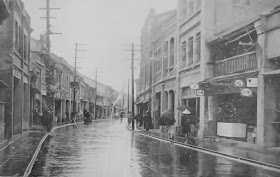Graduation photo of the 14th Advanced Class (Class of 1939) of Tamsui Public School [front row, 4th from left was one of EyeDoc's cousins and 5th from left, husband of EyeDoc's aunt] (Courtesy of Mr N Hirokawa).
There were two reports prepared by the British Consul then stationed in Tamsui, dated 3/4/1940 and 6/17/1941, respectively, commenting on the public education reform in Taiwan. Quoted in part:
"The Japanese policy of assimilation demands as its ultimate aim that the Formosans shall not merely be loyal subjects of the Emperor, but that they should think, talk, dress and live in a manner indistinguishable from home-born Japanese. All Formosan students are expected to speak Japanese only, not merely in the classrooms, but in their private intercourse. By the use of such means it is hoped that Japanese will supplant Chinese as the language in daily use among the people; but obviously the aim cannot be achieved without universal compulsory education. This reform has been long delayed by financial stringency, and so recently as 1935 it was estimated that not more than 37 per cent of Formosan children went to school. The present figure [note: 1940] is unknown, but is still fall far short of the aim. Now, however, at least the intention has been declared of introducing the compulsory system as follows: --
"Primary" schools ("shogakko [note: 小學校]")--for Japanese children only--compulsion to be applied from the fiscal year 1941-42--period of attendance, 6 to 14 years of age.
"Public" schools ("kogakko [note: 公學校]")--for Formosans--compulsion to be applied from 1943--period of attendance, apparently from 6 to 12 years of age.
Children in the "savage" districts will not be included in the scheme. This, however, represents a very small leakage, since there are only some 150,000 aborigines in the island as against 5,400,000 Formosans of Chinese race. Mo doubt the details of the scheme may be mended later."
Kids in Tamsui belonged in the 37% that had attended elementary schools by 1935. There was one 小學校 and two 公學校, the latter for boys and girls, separately [known as 淡水國小 and 文化國小 after 1945]. They were taught by Japanese teachers. In 1941, all schools were superseded by the common title Kokumingakko [i.e., national school 國民學校] and by 1943, locals were also among the ranks of the teachers and the students were no longer segregated.
Supplanting the mother tongue even in private conversation never took place - with non-Japanese-speaking parents, it was mission impossible. The 8-year education had already been implemented at least in Tamsui, since after advanced class (高等科, equivalent to junior high) in elementary schools, kids who qualified went on to senior high schools in either Tamsui or Taipei. The elite high schools in Taipei, the First High was attended by almost all Japanese and the Second High, by Taiwanese only. Many then received even higher education in medical schools or universities in Taiwan or Japan, even in the Japan-controlled Manchuria and Korea.
The British Consul had also noted in his 1941 report that
"...With the initial hardship of being educated in an alien language, it is obvious that on a shorter educational course the Formosan child can never hope to succeed in open competition with the Japanese. Indeed, his educational facilities are expressly designed to ensure that he shall not."and
"...since the island schools are used as an overflow of Japanese youths from Japan who cannot secure entry into schools in their own country, it is more likely that such new facilities as can be provided will benefit Japanese children rather than Formosan."
Again, the "shorter educational course" referred to the 6-year main student course [本科部]. While these observations might be factual, the Consul had not given Formosan children due credit for their ability to overcome any hardship, especially when the competition was with academic low-achievers from Japan.








